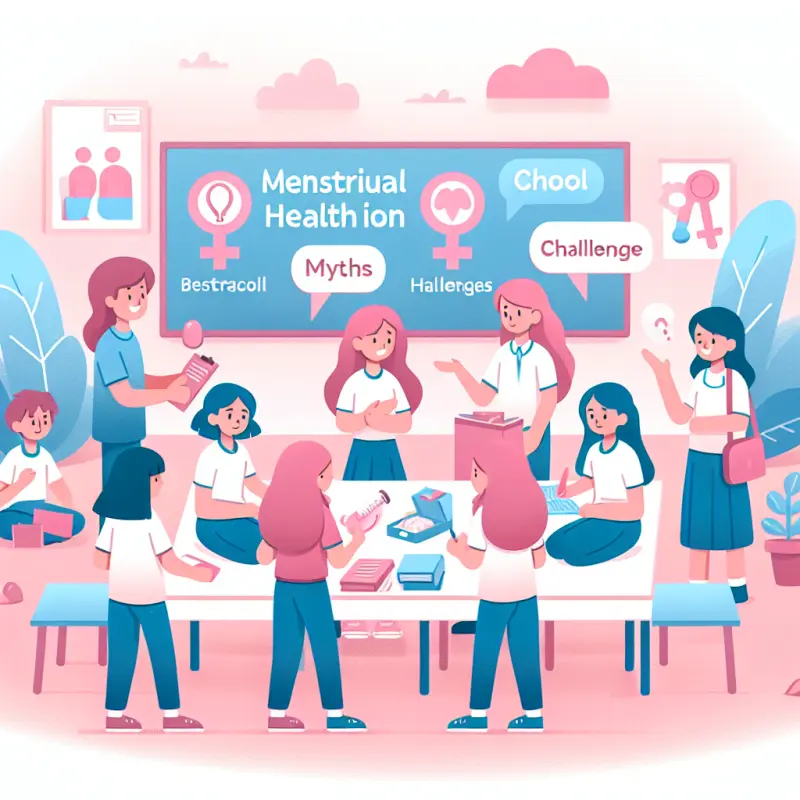Menstrual Health Education in Schools: Best Practices and Challenges

Menstrual Health Education in Schools: Best Practices and Challenges
Introduction
Menstrual health education is a crucial aspect of comprehensive health education in schools. It plays a vital role in equipping young students with the knowledge and skills they need to manage their menstrual health effectively. Despite its importance, menstrual health education is often inadequately covered in school curricula worldwide, leading to significant gaps in understanding and awareness among students. This article explores best practices for implementing menstrual health education in schools and discusses the challenges faced in doing so.
The Importance of Menstrual Health Education
Menstrual health education is not merely about teaching biology. It's about empowering students with the confidence and knowledge to manage their menstrual health, dismantling stigmas, and promoting gender equality. Proper education can lead to:
- Informed Decision-Making: Students can make informed choices about their menstrual health, hygiene, and wellbeing.
- Reduced Stigma and Shame: Education helps normalize menstruation, reducing the stigma and shame often associated with it.
- Improved Attendance and Participation: Understanding and managing menstruation can lead to better school attendance and participation, particularly for girls.
- Healthier Communities: Educated students can share their knowledge, fostering healthier attitudes and practices in the community.
Best Practices in Menstrual Health Education
Comprehensive Curriculum
A well-rounded curriculum should cover:
- Biological Aspects: Understanding the menstrual cycle, its phases, and how it affects the body.
- Hygiene Practices: Information on menstrual hygiene products and their safe disposal.
- Emotional and Social Aspects: Addressing emotional changes and societal attitudes towards menstruation.
- Inclusivity: Education should be inclusive of all genders, acknowledging that menstruation is not just a "girls' issue."
Teacher Training
Teachers play a pivotal role in delivering menstrual health education. Proper training can ensure they are well-equipped to handle:
- Sensitive Topics: Teachers must be comfortable discussing menstruation openly and sensitively.
- Student Questions: Training helps teachers address students' queries accurately and confidently.
- Cultural Sensitivities: Teachers should be aware of and respect cultural attitudes towards menstruation.
Student Engagement
Engaging students through interactive and participatory methods can enhance learning outcomes. Strategies include:
- Workshops and Seminars: Involving health professionals to conduct workshops can provide expert insights.
- Peer Education: Training students to educate their peers can create a supportive environment.
- Use of Multimedia: Incorporating videos, animations, and interactive content can make learning more engaging.
Parental Involvement
Parents play a crucial role in reinforcing menstrual health education at home. Schools can facilitate this by:
- Organizing Parent Workshops: Educating parents on how to talk to their children about menstruation.
- Providing Resources: Offering booklets and online resources for parents to use at home.
- Encouraging Open Communication: Promoting a dialogue between parents and children about menstrual health.
Challenges in Implementing Menstrual Health Education
Cultural Taboos and Stigmas
In many cultures, menstruation is shrouded in taboo and stigma, posing significant barriers to education. Overcoming these challenges requires:
- Cultural Sensitivity: Tailoring education programs to respect cultural beliefs while promoting health.
- Community Engagement: Involving community leaders and influencers in educational initiatives.
- Long-Term Commitment: Sustained efforts to change cultural perceptions over time.
Lack of Resources
Resource constraints can hinder the implementation of effective menstrual health education. Solutions include:
- Funding and Support: Seeking government and NGO support for resources and materials.
- Low-Cost Programs: Developing cost-effective educational materials and programs.
- Partnerships: Collaborating with organizations that specialize in menstrual health.
Insufficient Policy Frameworks
The absence of strong policy frameworks can limit the scope and effectiveness of education programs. Advocacy efforts should focus on:
- Policy Development: Working with policymakers to integrate menstrual health education into national curricula.
- Monitoring and Evaluation: Establishing systems to assess the effectiveness of education programs.
- International Collaboration: Learning from countries with successful menstrual health education policies.
Gender Inequality
Gender inequality can exacerbate challenges in delivering menstrual health education. Addressing this requires:
- Gender-Sensitive Education: Ensuring that education programs promote gender equality and respect.
- Empowerment Initiatives: Encouraging girls to take leadership roles in education programs.
- Boys' Inclusion: Educating boys about menstruation to foster empathy and understanding.
Conclusion
Menstrual health education is an essential component of a comprehensive school health program. By adopting best practices and addressing challenges head-on, schools can play a pivotal role in normalizing menstruation and promoting gender equality. This not only benefits individual students but also contributes to healthier, more informed communities. To achieve this, collaboration between educators, parents, policymakers, and communities is crucial. With concerted efforts, we can ensure that every student receives the menstrual health education they deserve, paving the way for a more equitable and understanding society.